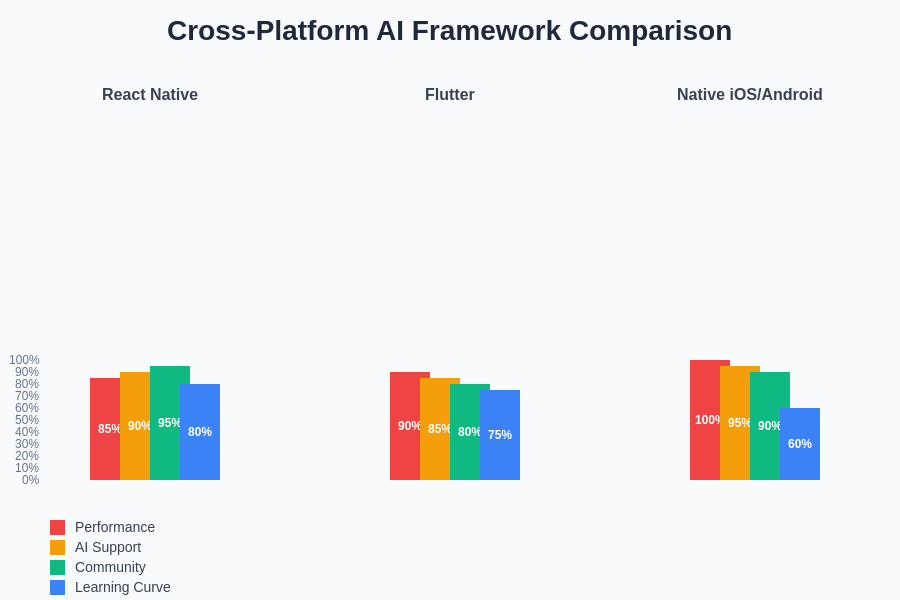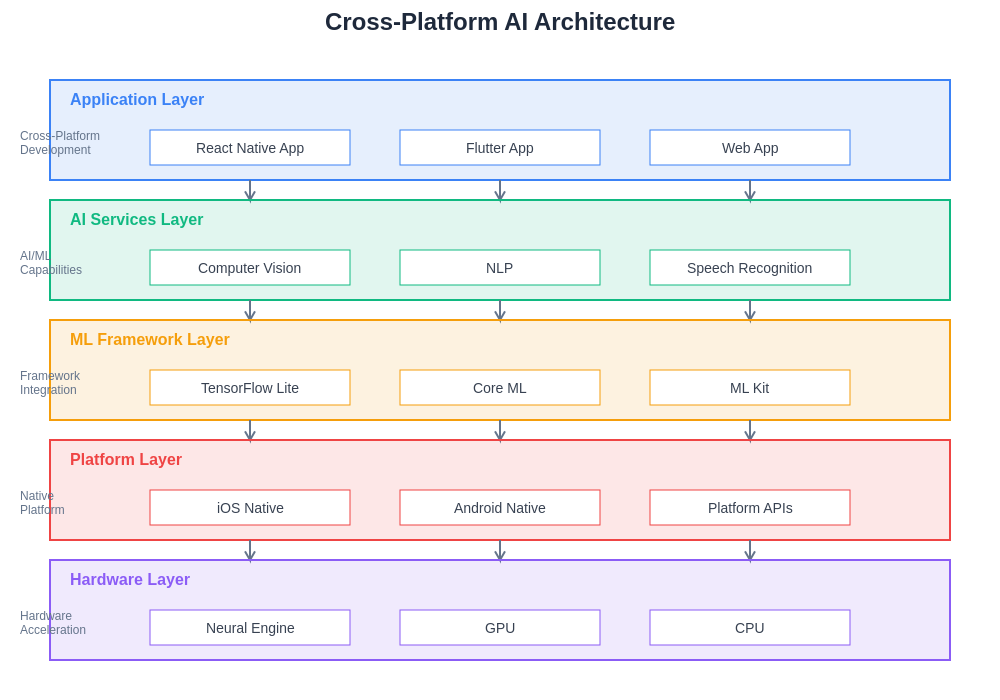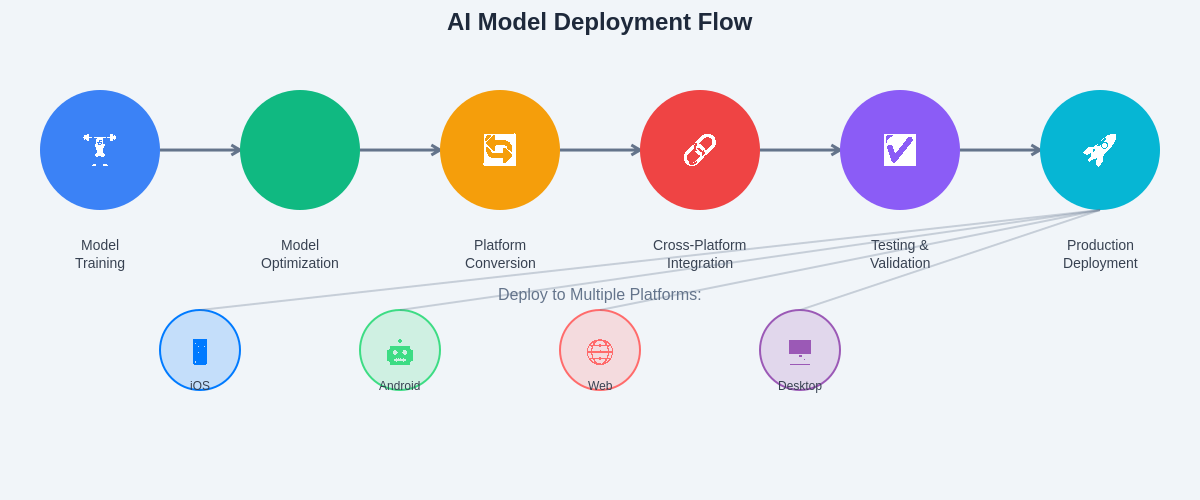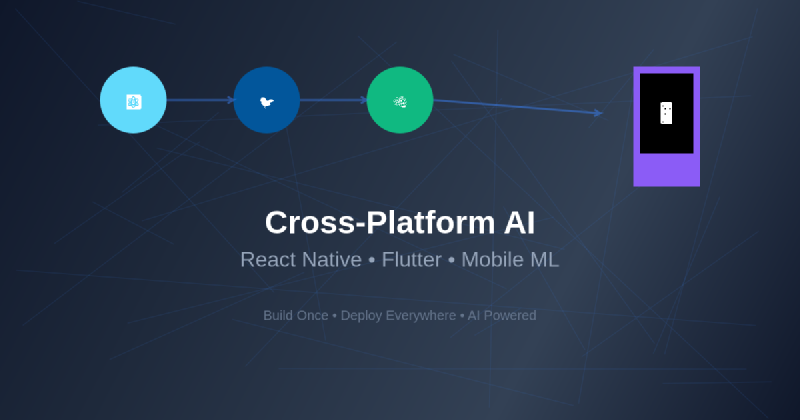The convergence of artificial intelligence and cross-platform mobile development has created unprecedented opportunities for developers to build sophisticated AI-powered applications that reach users across multiple platforms with a single codebase. The integration of machine learning capabilities into React Native and Flutter applications represents a paradigm shift in mobile development, enabling developers to deploy advanced AI features from computer vision to natural language processing without the complexity and cost of maintaining separate native codebases for each platform.
Explore the latest AI development trends to understand how cross-platform AI technologies are evolving and shaping the future of mobile application development. The ability to leverage powerful machine learning models across iOS and Android platforms through unified development frameworks has democratized AI implementation, making advanced intelligent features accessible to development teams of all sizes and technical backgrounds.
The Evolution of Cross-Platform AI Development
Cross-platform AI development has evolved from a theoretical possibility to a practical reality through the maturation of frameworks like React Native and Flutter, combined with advances in mobile machine learning libraries such as TensorFlow Lite, Core ML, and ML Kit. This evolution has been driven by the increasing demand for AI-powered mobile applications and the need to reduce development time and costs while maintaining high performance and user experience standards across different platforms.
The traditional approach to mobile AI implementation required separate development efforts for iOS and Android, each with platform-specific machine learning frameworks and optimization techniques. This fragmented approach often resulted in inconsistent user experiences, increased development overhead, and significant challenges in maintaining feature parity across platforms. Modern cross-platform AI frameworks have addressed these challenges by providing unified APIs and deployment mechanisms that enable developers to implement sophisticated AI features once and deploy them across multiple platforms.
The integration of AI capabilities into cross-platform frameworks has also benefited from significant improvements in mobile hardware, including dedicated neural processing units, increased memory capacity, and enhanced computational power that enables on-device machine learning inference. These hardware advances, combined with optimized mobile ML libraries, have made it possible to run complex AI models directly on mobile devices without requiring constant internet connectivity or cloud-based processing.
React Native and AI Integration
React Native has emerged as a leading platform for cross-platform AI development, offering robust integration capabilities with various machine learning frameworks and libraries. The framework’s JavaScript-based architecture provides flexibility in implementing AI features while maintaining near-native performance through its bridge architecture and native module system. React Native’s extensive ecosystem includes numerous AI-focused libraries and plugins that simplify the integration of machine learning capabilities into mobile applications.
Enhance your development workflow with Claude for intelligent code generation and AI implementation guidance that can accelerate your React Native AI development projects. The platform’s ability to leverage existing JavaScript machine learning libraries, combined with native module integration for performance-critical AI operations, creates a powerful development environment for building sophisticated AI-powered mobile applications.
The React Native ecosystem supports various AI implementation approaches, from lightweight JavaScript-based machine learning libraries like TensorFlow.js to native module integrations with TensorFlow Lite and Core ML. This flexibility enables developers to choose the most appropriate implementation strategy based on their specific requirements, performance constraints, and target platforms. The framework’s component-based architecture also facilitates the creation of reusable AI-powered components that can be easily integrated into different parts of an application or shared across multiple projects.
React Native’s integration with cloud-based AI services has also been streamlined through various SDK implementations and API integrations that enable developers to leverage powerful cloud-based machine learning models while maintaining the benefits of cross-platform development. This hybrid approach combines the efficiency of cross-platform development with the computational power of cloud-based AI services, creating applications that can perform both on-device and cloud-based AI inference depending on specific use case requirements.

The comparative analysis of cross-platform frameworks reveals distinct strengths and considerations for AI implementation, with each platform offering unique advantages in performance optimization, AI library support, community resources, and development learning curves that influence the selection of appropriate frameworks for specific AI-powered mobile applications.
Flutter’s Approach to Mobile AI
Flutter’s unique architecture and Dart programming language have created distinct advantages for AI development, particularly in terms of performance consistency and UI flexibility. Flutter’s widget-based architecture enables seamless integration of AI-powered features with custom user interfaces, while the framework’s compilation to native code ensures consistent performance across platforms. The growing Flutter ecosystem includes specialized packages for machine learning integration, including TensorFlow Lite plugins, image processing libraries, and computer vision tools.
The framework’s hot reload capability significantly accelerates AI development workflows by enabling rapid iteration and testing of machine learning features without lengthy rebuild processes. This development efficiency is particularly valuable when fine-tuning AI model parameters, adjusting user interface elements, or optimizing performance across different devices and screen sizes. Flutter’s declarative UI approach also simplifies the implementation of dynamic interfaces that respond to AI model outputs and user interactions.
Flutter’s integration with Firebase ML Kit and other Google AI services provides developers with easy access to powerful pre-trained models for text recognition, image labeling, face detection, and barcode scanning. These integrations are particularly valuable for developers who need to implement common AI features quickly without the complexity of training custom models or managing machine learning infrastructure. The framework’s plugin architecture also enables seamless integration with custom native AI implementations when specific requirements demand platform-optimized solutions.
Mobile Machine Learning Frameworks
The landscape of mobile machine learning frameworks has expanded significantly, providing developers with numerous options for implementing AI features in cross-platform applications. TensorFlow Lite stands out as a leading framework, offering optimized model deployment for mobile devices with support for both React Native and Flutter through various integration approaches. The framework’s model optimization capabilities, including quantization and pruning, enable developers to deploy sophisticated AI models while maintaining acceptable performance on resource-constrained mobile devices.
Core ML, Apple’s machine learning framework, provides exceptional performance optimization for iOS devices while offering integration pathways for cross-platform frameworks through native modules and plugins. The framework’s hardware acceleration capabilities, including Neural Engine utilization on supported devices, enable high-performance AI inference that would be difficult to achieve through platform-agnostic approaches. Cross-platform frameworks have developed various integration strategies to leverage Core ML’s capabilities while maintaining code portability.
Utilize Perplexity for comprehensive AI research to stay informed about emerging mobile ML frameworks and implementation strategies that can enhance your cross-platform AI development projects. The rapid evolution of mobile ML frameworks requires continuous learning and adaptation to leverage the latest capabilities and optimization techniques.
ML Kit, Google’s mobile machine learning SDK, provides ready-to-use APIs for common AI tasks including text recognition, face detection, pose estimation, and natural language processing. The framework’s cross-platform support and cloud-based model capabilities make it particularly attractive for developers who need to implement AI features quickly without extensive machine learning expertise. ML Kit’s integration with cross-platform frameworks has been streamlined through various community-developed plugins and official SDK implementations.

The layered architecture approach to cross-platform AI implementation demonstrates the complex interplay between application frameworks, AI services, machine learning libraries, platform-specific optimizations, and hardware acceleration capabilities that must be coordinated to deliver effective AI-powered mobile experiences across different platforms and devices.
Performance Optimization Strategies
Performance optimization in cross-platform AI applications requires careful consideration of multiple factors including model size, inference speed, memory usage, and battery consumption. The challenge of maintaining consistent performance across different devices and platforms necessitates comprehensive optimization strategies that address both framework-specific and AI-specific performance considerations. Effective optimization often involves a combination of model optimization techniques, efficient data processing pipelines, and strategic use of device-specific acceleration features.
Model optimization techniques such as quantization, pruning, and knowledge distillation can significantly reduce model size and inference time while maintaining acceptable accuracy levels. These techniques are particularly important in cross-platform environments where applications must perform consistently across devices with varying computational capabilities. The selection and implementation of optimization techniques must consider the specific requirements of target platforms and the trade-offs between model accuracy and performance.
Memory management becomes critical in AI-powered cross-platform applications, particularly when implementing real-time features such as camera-based object detection or continuous speech recognition. Efficient memory allocation strategies, proper disposal of AI model resources, and careful management of intermediate processing results are essential for maintaining application stability and user experience quality. Cross-platform frameworks provide various tools and techniques for monitoring and optimizing memory usage in AI applications.
Battery optimization is another crucial consideration, as AI operations can be computationally intensive and impact device battery life significantly. Strategies such as adaptive inference frequency, intelligent caching of AI results, and strategic use of cloud-based processing can help minimize battery impact while maintaining feature functionality. The implementation of these strategies must consider user experience implications and provide appropriate controls for users to manage AI feature usage based on their preferences and device constraints.
Computer Vision Implementation
Computer vision represents one of the most popular and impactful applications of AI in mobile development, with cross-platform frameworks providing increasingly sophisticated tools for implementing features such as object detection, image classification, face recognition, and augmented reality experiences. The implementation of computer vision features in cross-platform applications involves careful consideration of camera integration, real-time processing requirements, and user interface design that accommodates AI-powered visual features.
Camera integration across platforms presents unique challenges and opportunities, with each platform offering different camera APIs and capabilities. Cross-platform frameworks have developed various approaches to unify camera access while maintaining platform-specific optimization opportunities. The implementation of real-time computer vision features requires efficient camera stream processing, optimized AI model inference, and smooth integration with application user interfaces.
Image preprocessing and post-processing pipelines play crucial roles in computer vision implementation, affecting both accuracy and performance of AI models. Cross-platform frameworks provide various image processing libraries and utilities that enable developers to implement efficient preprocessing workflows while maintaining code portability. The optimization of these pipelines often involves platform-specific considerations and may benefit from native module implementations for performance-critical operations.
Augmented reality integration has become increasingly popular in cross-platform AI applications, combining computer vision capabilities with immersive user experiences. The implementation of AR features requires sophisticated coordination between camera input, AI processing, and 3D rendering capabilities. Cross-platform frameworks have developed various approaches to AR integration, from plugin-based solutions to comprehensive AR development platforms that provide unified APIs across different platforms.
Natural Language Processing Integration
Natural language processing capabilities have become essential features in many mobile applications, enabling sophisticated text analysis, language translation, sentiment analysis, and conversational interfaces. Cross-platform frameworks provide various approaches to NLP integration, from lightweight on-device processing to cloud-based services that offer advanced language understanding capabilities. The selection of appropriate NLP implementation strategies depends on factors such as privacy requirements, offline functionality needs, and the complexity of language processing tasks.
On-device NLP implementation offers advantages in terms of privacy and offline functionality but requires careful model optimization to ensure acceptable performance on mobile devices. Cross-platform frameworks support various lightweight NLP libraries and optimized model implementations that enable basic text processing tasks without requiring internet connectivity. These implementations are particularly valuable for applications that handle sensitive user data or need to function reliably in environments with limited connectivity.
Cloud-based NLP services provide access to sophisticated language models and processing capabilities that would be impractical to implement on mobile devices. Cross-platform frameworks facilitate integration with various cloud NLP services through standardized API implementations and authentication mechanisms. The hybrid approach of combining on-device processing for basic tasks with cloud-based processing for complex operations enables applications to provide comprehensive NLP capabilities while managing performance and cost considerations.
Conversational AI integration has become increasingly sophisticated, with cross-platform frameworks supporting various chatbot and virtual assistant implementations. These integrations often combine speech recognition, natural language understanding, dialog management, and text-to-speech capabilities to create comprehensive conversational experiences. The implementation of conversational AI in cross-platform applications requires careful consideration of user interface design, conversation flow management, and integration with backend services that provide AI-powered responses.
Audio Processing and Speech Recognition
Audio processing and speech recognition represent critical components of AI-powered mobile applications, enabling features such as voice commands, audio transcription, music recognition, and ambient sound analysis. Cross-platform frameworks have developed robust support for audio processing through various native module integrations and JavaScript-based audio processing libraries. The implementation of audio AI features requires careful consideration of microphone access permissions, real-time processing requirements, and user privacy concerns.
Speech recognition implementation in cross-platform applications involves integration with both on-device and cloud-based speech processing services. On-device speech recognition offers advantages in terms of privacy and offline functionality but may have limitations in terms of accuracy and language support compared to cloud-based alternatives. Cross-platform frameworks provide various approaches to speech recognition integration, enabling developers to choose the most appropriate solution based on their specific requirements and constraints.
Audio classification and analysis capabilities enable applications to understand and respond to various audio environments and conditions. These features can be implemented using machine learning models trained on audio data, with cross-platform frameworks providing the necessary tools for audio data processing and model inference. Applications ranging from environmental monitoring to music recommendation systems benefit from these audio AI capabilities.
Voice synthesis and text-to-speech integration complete the audio AI ecosystem, enabling applications to generate natural-sounding speech from text input. Cross-platform frameworks support various text-to-speech implementations, from platform-native speech synthesis to cloud-based services that offer more natural and customizable voice options. The integration of voice synthesis capabilities enables applications to provide comprehensive audio-based user interfaces and accessibility features.
Data Management and Privacy Considerations
Data management in cross-platform AI applications involves complex considerations around data collection, storage, processing, and privacy protection. The implementation of AI features often requires access to sensitive user data such as camera images, audio recordings, location information, and personal communications. Cross-platform frameworks must provide robust mechanisms for managing this data while ensuring compliance with various privacy regulations and user expectations.
Local data storage strategies become crucial when implementing on-device AI features that require persistent model storage, user data caching, and offline functionality. Cross-platform frameworks provide various local storage options, from simple key-value stores to sophisticated database implementations that can handle the complex data requirements of AI applications. The selection of appropriate storage strategies must consider factors such as data volume, access patterns, and synchronization requirements across different platforms.
Privacy-preserving AI techniques have become increasingly important as users become more conscious of data privacy concerns. Cross-platform frameworks support various privacy-enhancing approaches including federated learning, differential privacy, and on-device processing that minimizes data transmission to external services. The implementation of these techniques requires careful balance between privacy protection and feature functionality, with consideration for user control and transparency.
Data synchronization across platforms presents unique challenges in cross-platform AI applications, particularly when implementing features that learn from user behavior or adapt to individual preferences. Cross-platform frameworks provide various synchronization mechanisms, from simple cloud storage integration to sophisticated conflict resolution systems that can handle complex data relationships. The design of data synchronization strategies must consider offline functionality, data consistency, and user privacy requirements.
Testing and Quality Assurance
Testing AI-powered cross-platform applications requires specialized approaches that address both traditional software testing concerns and AI-specific challenges such as model accuracy, performance consistency, and edge case handling. The non-deterministic nature of many AI systems complicates traditional testing approaches and requires development of comprehensive testing strategies that can validate AI functionality across different platforms and usage scenarios.
Automated testing frameworks for cross-platform AI applications must accommodate the variability inherent in AI systems while providing reliable validation of core functionality. This often involves development of custom testing utilities that can generate appropriate test data, validate AI model outputs within acceptable ranges, and detect performance regressions across different devices and platforms. The integration of AI testing into continuous integration pipelines requires careful consideration of computational requirements and testing data management.
Performance testing becomes particularly critical in cross-platform AI applications due to the computational intensity of machine learning operations and the variability of device capabilities across different platforms. Comprehensive performance testing must evaluate AI feature performance across representative device configurations while identifying potential bottlenecks and optimization opportunities. This testing often requires specialized tools and metrics that can accurately measure AI-specific performance characteristics.
User experience testing for AI features requires consideration of factors such as AI accuracy, response time, and user interaction patterns that may differ significantly from traditional application features. The testing of AI-powered user interfaces must evaluate both functional correctness and user satisfaction with AI-generated results. This often involves user studies and feedback collection mechanisms that can capture user perceptions of AI feature quality and usefulness.
Deployment and Distribution Strategies
Deployment and distribution of cross-platform AI applications involve unique considerations around app store policies, model updates, and platform-specific optimization requirements. App store review processes may require special attention to AI features, particularly those that process user-generated content or make automated decisions that could impact user experience. Cross-platform frameworks must provide deployment strategies that accommodate these review requirements while maintaining development efficiency.
Model update mechanisms become crucial for AI applications that need to improve accuracy or add new capabilities over time. Cross-platform frameworks support various approaches to model updates, from traditional app store updates to over-the-air model delivery systems that can update AI capabilities without requiring full application updates. The implementation of model update systems must consider factors such as download size, update frequency, and backward compatibility requirements.
Platform-specific optimization during deployment can significantly impact AI application performance while maintaining cross-platform development benefits. This may involve generation of platform-optimized AI models, configuration of hardware acceleration features, or implementation of platform-specific performance optimizations. Cross-platform deployment pipelines must accommodate these optimizations while maintaining consistent functionality across platforms.
Distribution strategy considerations include factors such as app size optimization, regional availability, and compliance with local regulations regarding AI and data processing. Cross-platform frameworks provide various tools and approaches for managing these distribution challenges while maintaining development efficiency and feature consistency across different markets and platforms.

The comprehensive deployment workflow for machine learning models in cross-platform applications encompasses training optimization, platform-specific conversion, integration testing, and multi-platform distribution strategies that ensure consistent AI functionality across diverse mobile environments while maintaining development efficiency and deployment reliability.
Future Trends and Emerging Technologies
The future of cross-platform AI development is being shaped by several emerging trends including edge AI acceleration, federated learning implementations, and integration with emerging technologies such as augmented reality and Internet of Things devices. Cross-platform frameworks are evolving to support these emerging capabilities while maintaining their core advantages of development efficiency and code portability.
Edge AI acceleration through specialized hardware and optimized frameworks promises to enable more sophisticated on-device AI capabilities while maintaining acceptable performance and battery usage. Cross-platform frameworks are developing support for these hardware acceleration features through platform-specific integrations that can be accessed through unified APIs. This evolution will enable more capable AI features while preserving cross-platform development benefits.
Federated learning and collaborative AI approaches are becoming increasingly important as privacy concerns and data regulations drive demand for AI systems that can learn from distributed data without centralizing sensitive information. Cross-platform frameworks are beginning to support federated learning implementations that can coordinate model training across multiple devices while maintaining user privacy and data security.
The integration of cross-platform AI with emerging technologies such as wearable devices, smart home systems, and automotive platforms represents significant growth opportunities. Cross-platform frameworks are expanding their platform support and developing new integration capabilities that enable AI applications to interact with diverse device ecosystems while maintaining development efficiency and feature consistency.
The continued evolution of machine learning models and training techniques will drive ongoing improvements in cross-platform AI capabilities. Advances in model compression, transfer learning, and automated machine learning will make sophisticated AI features more accessible to cross-platform developers while reducing the expertise required for successful AI implementation. These advances promise to democratize AI development further and enable more innovative applications of artificial intelligence in mobile and cross-platform environments.
Conclusion
Cross-platform AI development using React Native, Flutter, and mobile ML frameworks represents a transformative approach to building intelligent mobile applications that reach users across multiple platforms efficiently and effectively. The convergence of mature cross-platform development frameworks with advanced mobile machine learning capabilities has created unprecedented opportunities for developers to implement sophisticated AI features without the complexity and cost of maintaining separate native codebases.
The continued evolution of these technologies promises even greater capabilities and easier implementation paths, making AI-powered features accessible to development teams of all sizes and technical backgrounds. Success in cross-platform AI development requires understanding of both cross-platform development principles and AI implementation considerations, but the investment in this knowledge pays dividends in terms of development efficiency, feature consistency, and market reach.
As mobile devices become increasingly powerful and AI technologies continue to advance, cross-platform AI development will play an increasingly important role in delivering innovative user experiences that leverage the full potential of artificial intelligence while maintaining the practical benefits of efficient, portable development approaches.
Disclaimer
This article is for informational purposes only and does not constitute professional advice. The technologies and frameworks discussed are subject to rapid evolution, and readers should conduct their own research and testing before implementing AI features in production applications. Performance characteristics, platform support, and feature availability may vary depending on specific implementation approaches and target platforms. Readers should consider privacy, security, and regulatory requirements when implementing AI features in mobile applications.
